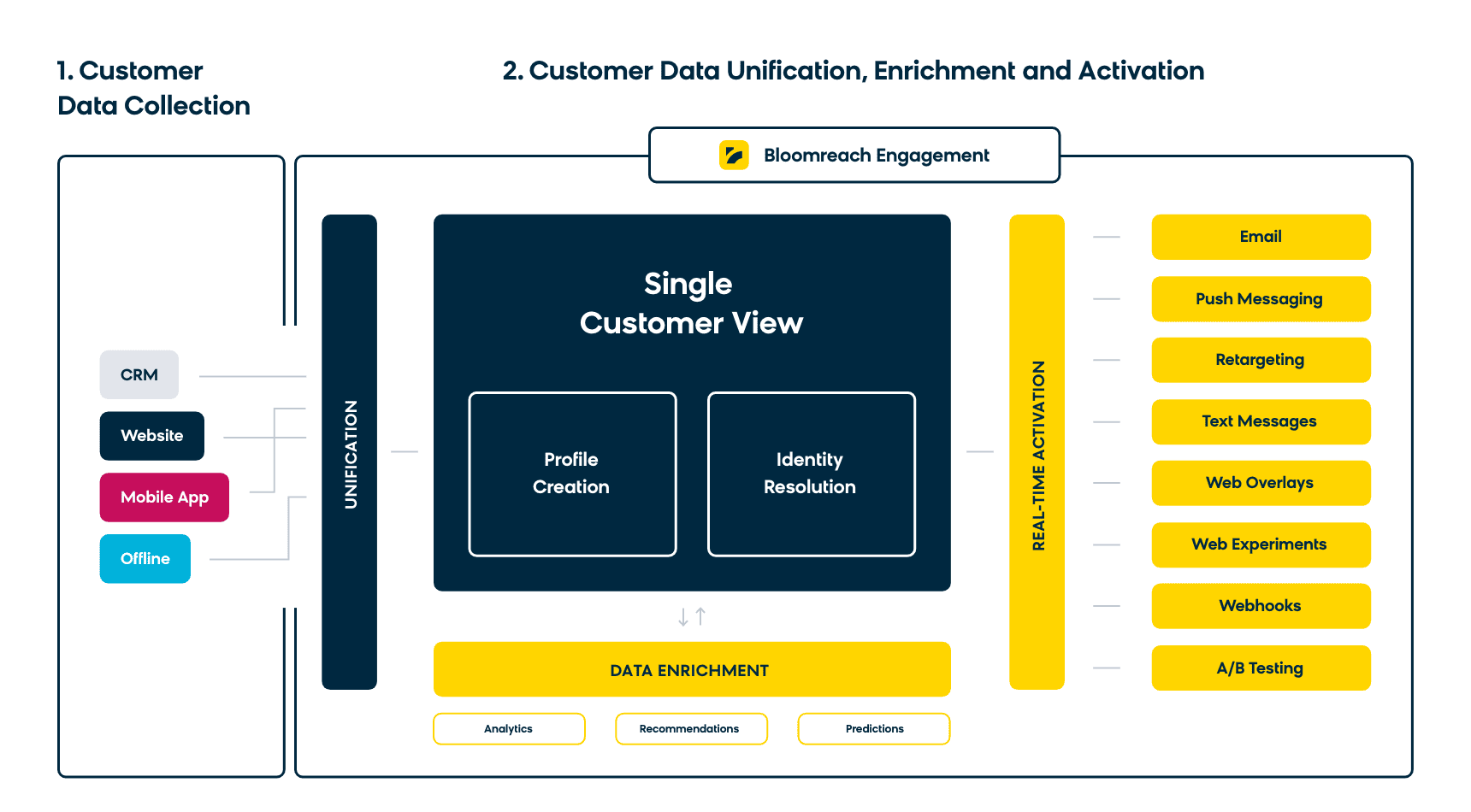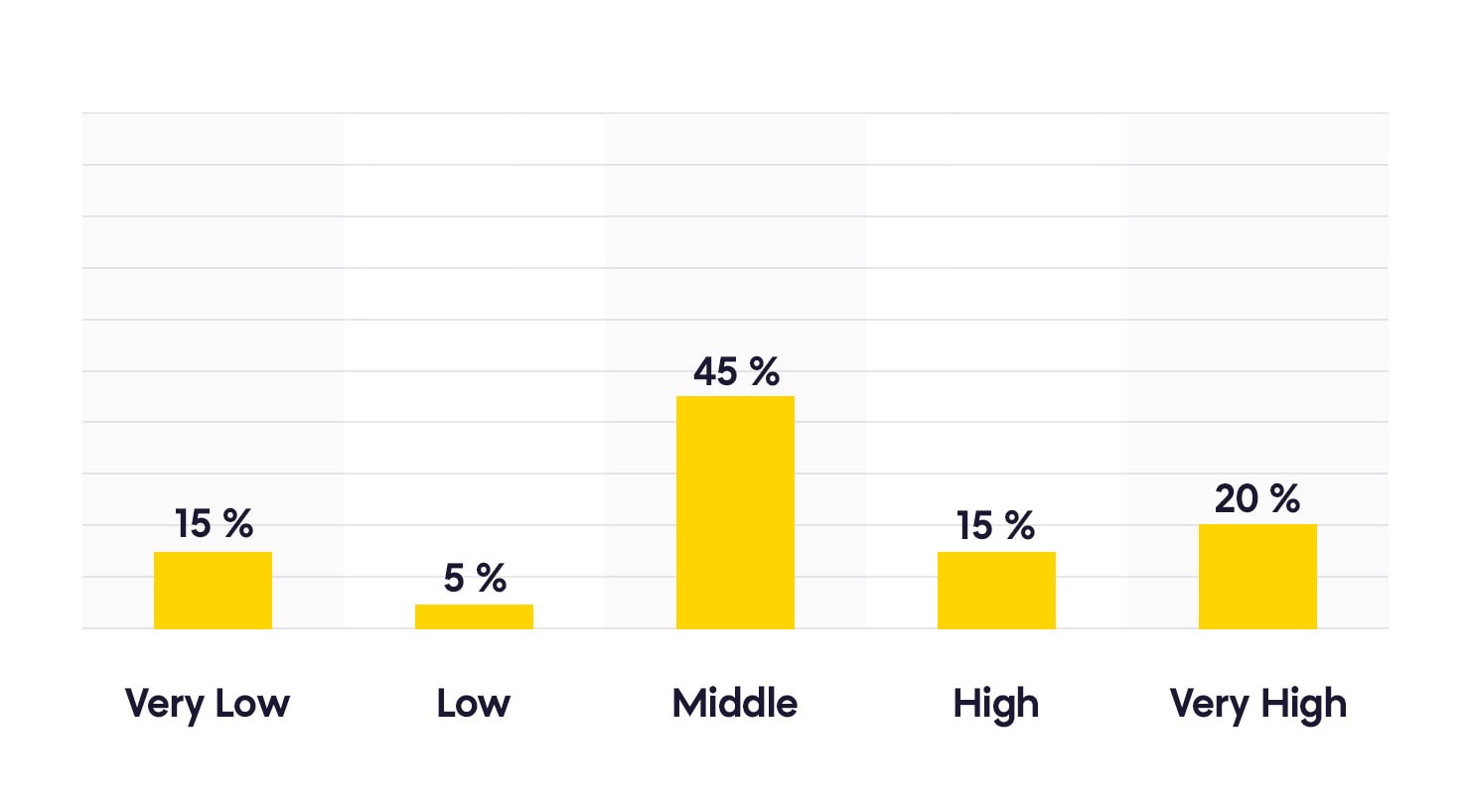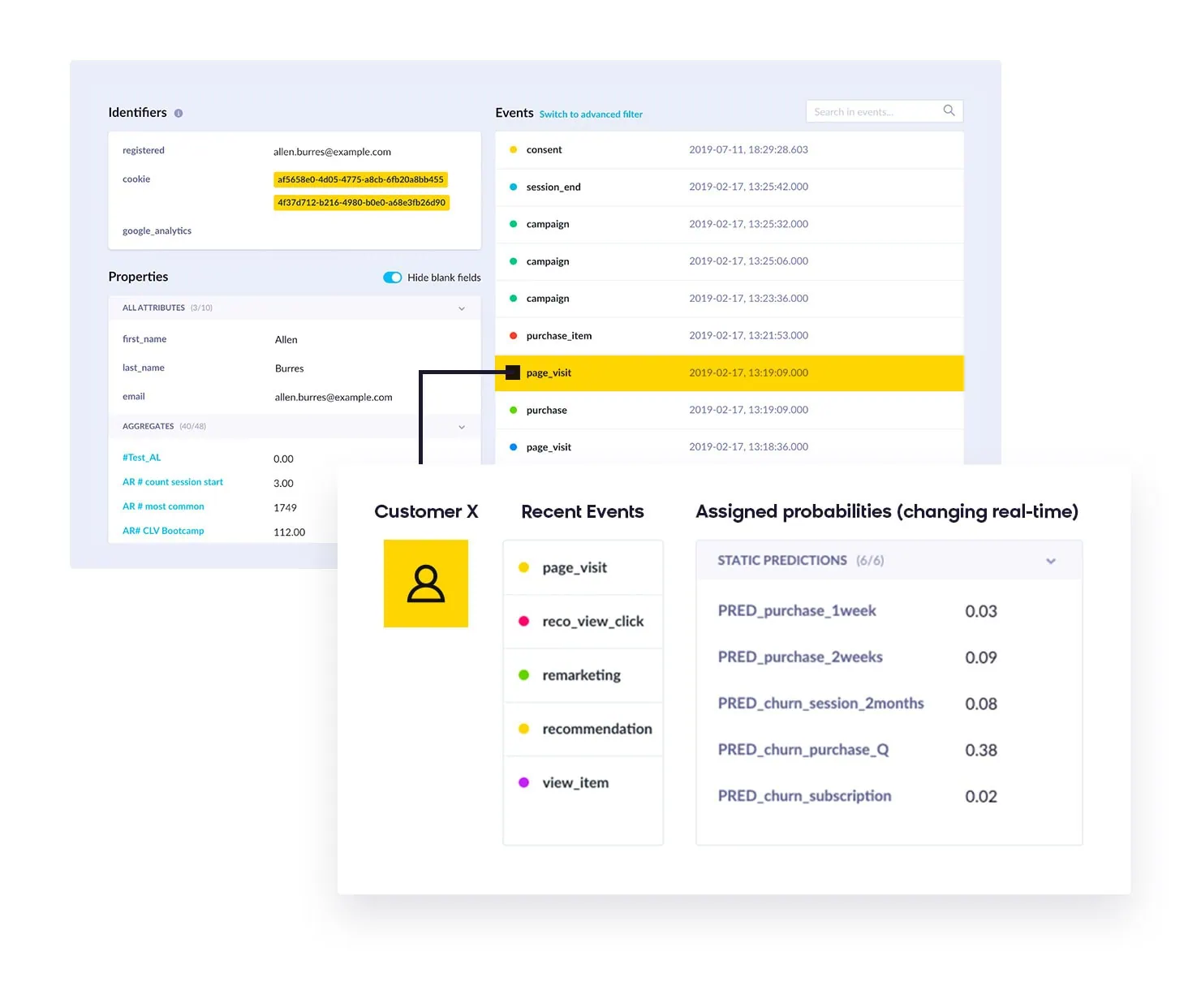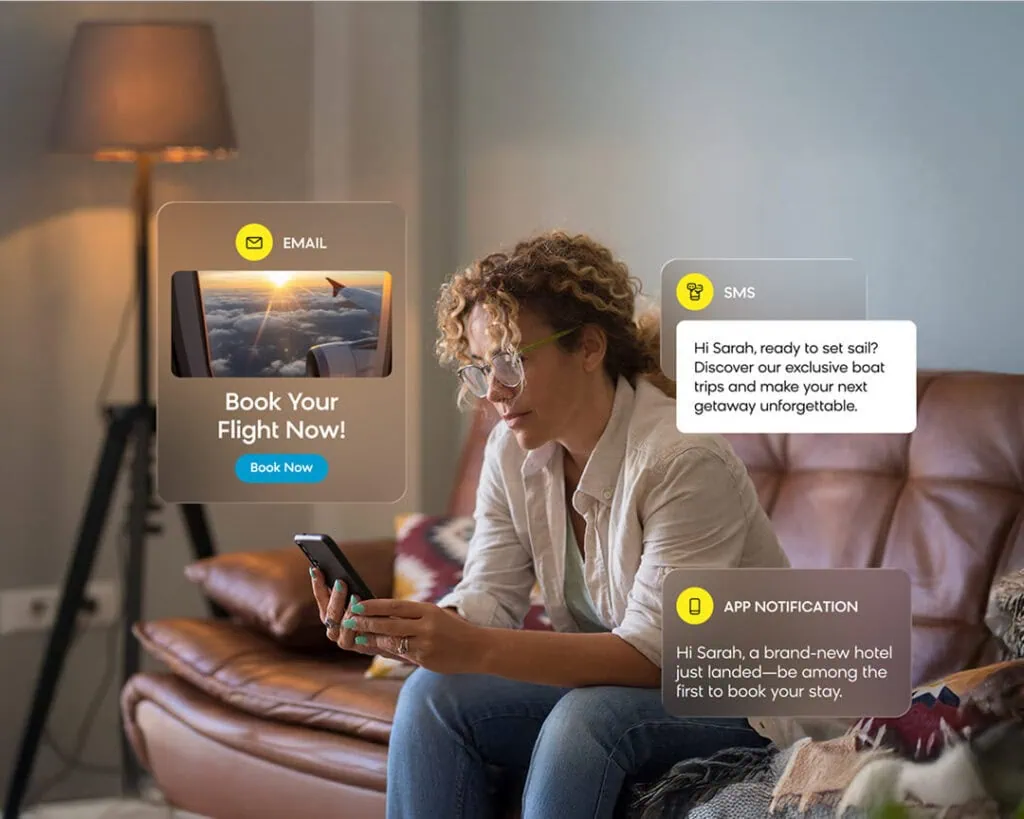Leaders in digital commerce contend with a growing array of challenges as digital technologies raise the competitive bar.
Yet with the advancement of the customer data platform (CDP), AI-powered predictive analytics are more accessible, more applicable, and more powerful than ever before, providing the next advantageous step towards unlocking unprecedented growth.
This article offers the latest on navigating these changes and insights to capitalize on the opportunities they present. The question is: are you achieving your maximum digital potential?
Key Takeaways
For Senior/BI Analysts and CMOs
- Customer data platforms (CDPs) provide the backbone to create successful predictive analyses, including a unified view of the customer, cross-departmental access to data, and real-time results.
- Having your data ducks in a row unlocks the next best thing: predictive analytics and the use of historical data to identify the right audience for your next actionable marketing campaign.
- Predictive analytics utilizes attributes found in a customer’s profile, and analyzes recent events to assign the probability of the next occurring event. Take customer knowledge even further by uncovering insights found in decision trees.
Introduction
You find yourself approaching security at the airport; which line do you choose?
Your brain instantly kick-starts a “predictive algorithm” with a set of parameters.
With multiple variations you start to differentiate with an array of predictors (line-length, number of bags, traveling families, the average age of each traveller in line, and so on), where an expected output is always the same: finding the fastest line.
Thus the target variable represents the time spent in line — the shorter the better — to achieve the fastest possible path to catch your flight. And yes, you’re armed with historical data full of previous security experiences that can help in your quick decision.
This process of calculating the foreseeable future is called a predictive analysis.
Computers can follow the same process with greater accuracy; their conclusions are backed by well-defined mathematical and statistical methods, and are often complimented with enormous amounts of data.
The Biggest Challenges of B2C Marketing
What can we solve with predictive analytics? Here are a few characteristics that have blown a hole of opportunity in the market:
- Inefficient matching of supply and demand, including the inability to target customers effectively.
- Loss of confidence in the brand or product, often caused by an inconsistent customer experience, leading to high customer attrition.
- Prevalence of underutilized assets in situations prior to purchase.
Fortunately, the right tools and tactics can turn any major problem into an advantage that can be used against the competition.
Predictive Analytics and Customer Data
What bare-data-essentials are needed for predictive analytics to work? To start, you’ll need to organize your customer data with a CDP.
What is a Customer Data Platform?
A CDP is software that unifies customer data from all touchpoints, cleaning, combining, and IDing it to create individual customer profiles. The newly organized database makes up-to-date customer information accessible to other systems and departments. The visualization of this data is called a single customer view (SCV).
The CDP is an essential tool to make customer data usable when facing siloed, static customer views that limit target market understanding, duplicated data entries that wreak havoc when delivering tailored messages, or even detached offline and online marketing channels.
Take the above image into consideration:
- Data is collected from a wide range of sources in real-time, including both online (existing CRM, website data, mobile applications, etc.) and offline (brick-and-mortar, direct-mail, loyalty programs, etc.) activities.
- Customer data is then consolidated and organized into an SCV, with individual profiles connected to customer ID.
- This universal source of customer data is made accessible by other systems for the use of analytics, recommendations, predictions and other business cases.
Having your data ducks in a row through use of a CDP enables you to unlock the full potential of predictive analytics.
What’s Predictive Analytics?
Predictive analytics uses past data for the purpose of predicting future events.
What predictive analytics does is feed off of historical customer data to provide accurate predictions of future events. What predictive analytics does not do is predict trends or future recessions. That’s reserved for the likes of Facebook and Google.
Its focus is on micro-level predictions (individual interactions with customers, suppliers, employees, etc.) rather than the macro-level predictions (trends, average behavior or generalities).
Simply put, predictions are used when establishing business goals to identify the right audience for your next actionable steps.
How Does Predictive Analytics Work?
Predictive customer analytics identifies specific users and their needs as time progresses.
When will the customer open our email newsletter? Will they return to buy again? How much money will they spend with me in the coming weeks? These are the questions that can be answered for each individual customer.
Here’s how it works.
Data is taken from two properties: events and customer attributes.
When comparing these historical values we can, for instance, determine what customer actions led to a successful second purchase in the past, and approach a similar customer segment to see how close they are to their second purchase now, thus predicting the likelihood of its occurrence.
Robert Lacok | AI Success Manager at Bloomreach
Predictive Analytics is more accessible than you might think: 2 mo. of historical customer data and/or 1k purchases per mo. is enough to start investigating.
Of course, the more data you have, the more insights you can uncover.
Therefore, by applying the “big” in “big data”, marketers can leverage large sets of customer data to analyse the various paths users take through their customer journey. These flowchart-like structures are called decision trees, where each node represents a customer decision and each branch an outcome.
By taking an in-depth look at where most customers end up, marketers can customise the best offers, interactions, or suppliers to boost what’s working in the wide-spectrum of desired results.
It also works in reverse, where ecommerce companies are not only identifying best practices, but can effectively diagnose limbs from the decision tree that lead to undesirable results—providing enough clarity to prepare efforts to, for example, reduce a customer’s likelihood to churn.
Remember our CDP? Having a single customer view for accessible data allows for the creation of these graphs in real time, representing actual customers that can be immediately investigated.
What’s special is at the end we receive an individual score assigned to each customer that represents their ranking within a certain segment, such as:
- A customer’s overall value to the company, called the Customer Lifetime Value (CLV).
- The likelihood of an event occurring, like probability of second purchase or churn as mentioned above.
- Or one of hundreds of other predefined ranges that can be analyzed.
With in-depth decision trees and customer ranking in various segments, you’re most certainly better informed about your shoppers, but what value does that bring to the company?
Why Use Predictive Analytics?
When communicating to your customers, how do you decide the frequency of emails you send?
Do you compare industry averages, A/B testing, or maybe by just waiting for them to unsubscribe? Are you 100% sure it’s the right way to go about it?
Predictive customer analytics is backed by real data, providing the closest possible answer to your desired questions. Where the score gives you the opportunity to decide what value, marketing spend, and energy should be invested into each customer segment. Analyzing the customer journey via decision trees can visualize the process, showing useful insights between those who purchased a second time and those who didn’t, unlocking access to improving their flow.
Together, predictive analytics creates a proof of concept: superior when reporting, unparallel when calculating your next actionable steps in a marketing campaign.
Better yet, a CDP allows you to see campaign results in real time, so you can watch as the volume improves as it moved down each stage of the marketing funnel.
While it’s not difficult to understand, it’s most certainly not the first step you take when setting up your ecommerce data infrastructure.
Many move from acquisition to retention strategies using recommendations, and on towards customer loyalty, employing A/B testing for key insights on customer behavior.
Prediction analytics is the latest innovation in our action plan:
Veronika Urbančoková | Machine Learning Engineer at Bloomreach
Remember: Recommendations ≠ Predictive Analytics. The first has more of a retention focus, creating personalization at scale, while the latter provides a better understanding of your loyalty strategy, improving personalization with segmentation—think loyalty analytics.
The Future of B2C Marketing
As the future unfolds, we’re beginning to see the unique attributes of CDPs combine forces with the enhanced capabilities of customer predictions to produce competitive results.
Instead of systematically A/B testing theories with two available options (where results must mature for months on end), predictions unlock a holistic approach that answer your hypothesis instantaneously with the use of historical data sets.
Real-time capabilities means each predictive value represents an actual customer at that exact time and place. There’s no sampling here, as each and every segments can be investigated accordingly.
Flexibility amassing practical knowledge of this scale is otherwise impossible without a CDP in place organizing your customer data.
Key Use Cases for Predictive Analytics
To fully understand the power of predictive customer analytics, it’s often beneficial to see where marketers are employing the medium to maintain ahead of the competitive curve.
Here are six use cases on what predictive analytics can do for your business:
Target effectively.
Purchase Predictions
Predict whether or not an offer will be accepted by the customer.
Removing redundant communication saves time and money by targeting fewer customers while achieving similar profits.
Open Email Prediction
Predict if the customer will open your email campaigns.
Approach the most engaged customers, while skipping those who aren’t interested.
Optimal Email Time Prediction
Take email even further by predicting the optimal time your customer will open their email.
Ensure your emails are read by sending them when they’re most likely to be seen.
Prevent Churn
Every individual customer tends to break relationship with the store sooner or later.
Highlight those who are most likely to churn and take care of their needs early.
Push Conversions
Excited customers who are impending conversion, tend to follow similar behavioral patterns.
Identify those that are ready and help them finish their session with a purchase.
Custom Predictions
Since every company relies on their own unique combination of key performance indicators (KPIs), the flexibility of predictive customer analytics allows for any unique specification parameters.
You’re really only limited to your imagination.
Using Predictive Behavior Modeling to Find High Value Customers
In terms of long-term strategy, predictive analytics can assist in discovering your most loyal customers through the CLV calculation.
By foster loyalty strategies with those that possess the highest value, ecommerce companies can create a continuous, profitable relationship, while simultaneously producing fanatical brand ambassadors as a by-product.
Understanding your die-hard fans allows for the recruitment of similar high-profile customers through the use of lookalike audiences.
Final Thoughts
When it comes to exciting new digital capabilities, predictive analytics is the forefront of understanding customer behavior while unlocking the ability to act, even with the use of automation, before they get there.
It’s the ability to amass practical knowledge that sets most ecommerce companies apart, while making use of this powerful analytics creates leaders in the industry.
At Bloomreach, we’re leading the way with the world’s #1 Commerce Experience Cloud that allows businesses to achieve true ecommerce personalization and drive business growth. Are you ready to test if predictive analytics is right for you to maximize your digital potential?
See what you’re missing out on — schedule a personalized demo today.
























